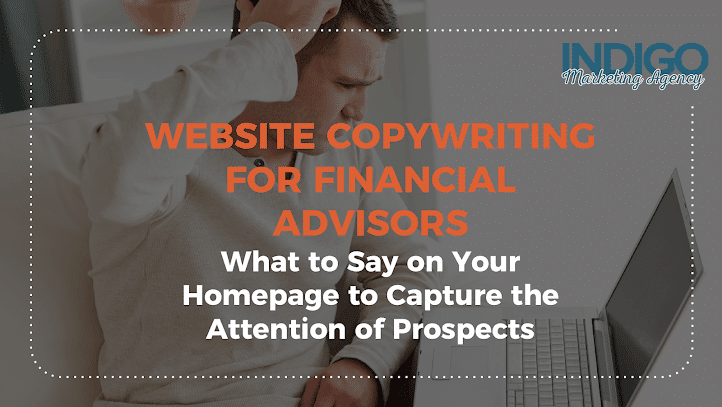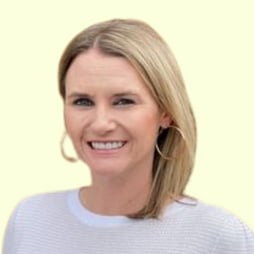
What does the text on your home page say? If you’re like most advisors, you probably don’t remember!
But the copy on your website is critical for capturing the fleeting attention of prospects.
Financial Copywriter
In this exclusive webinar with special expert guest Gerry Black, we’ll review what to say on your homepage to get the attention of prospects including:
- The most important words on your site
- The top website copy mistakes advisors make
- The three words to swap out and increase your conversion rate today
- How to overcome your visitors’ biggest fear
- Answering your prospects’ most important question
Sign up today for this limited edition guest expert webinar!
Meet Your Webinar Host

Claire Akin, MBA
Claire Akin runs Indigo Marketing Agency, a full-service marketing firm serving top independent financial advisors. She is a former Investment Advisor Representative and holds a Master’s Degree in Marketing. Claire works closely with several of Barron’s Top 100 Financial Advisors to grow their AUM using digital marketing.

Guest Speaker Gerry Black
Gerry Black is an expert website copywriter and the author of The CLIC Website Sales Lead System. He helps financial advisors to improve the copy on their websites and marketing materials. Gerry has 25 years experience in sales and marketing as well as a degree in journalism.
READ THE TRANSCRIPT BELOW
Claire Akin:
Hi, and thank you so much for joining us. I’m Claire Akin with Indigo Marketing Agency, and today I’m so excited to have a special guest, an expert website copywriter who’s helped tons of financial advisors write compelling website copy that gets their websites to convert. So today we’re going to talk about website copywriting for financial advisors with special guest, Gerry Black. And we’re going to go through how the text on your website can convert visitors to your site to actually take the next step with you.
So just a little bit of background on my story before we get started. I’m a former investment advisor representative. I got started in this industry with my dad, who’s a financial advisor with LPL, and he’s been in the business about 37 years. And so, I grew up working with him, so I really understand the challenges that financial advisors face, not only in their business, but also in their marketing.
And so I have a bachelor’s degree in economics, a master’s degree in marketing. And I also worked for a company called FMG Suite, which is a leading provider of websites and digital marketing solutions for advisors, before I started my own company, Indigo Marketing Agency. And what we do is we help independent financial advisors to really embrace a specialty through their marketing campaigns. And I do webinars like this every single month to help independent financial advisors like you to learn more about marketing, and get ideas and solutions that can help you to reach more clients. I’m also an instructor at UCLA Extension in their CFP program, where I teach advisors about marketing.
But let’s talk about something more important. Let’s talk about your story, and the story of your website. So you probably don’t even remember what your homepage says. And so this is a good test, what are the words that are front and center on your homepage right now? Do you even know without actually going to your website? Most advisers don’t. And that’s because you wrote your website years ago, or maybe somebody wrote it for you. You’re not a copywriting expert, and you’re just not sure what to say to get prospects’ attention and to convert them. So that’s why we brought in our special guest today to help us understand what really works for financial advisors. What words should we put on your homepage, and what should we be thinking about and saying through the copy on your site to actually get people interested in what you have to offer?
So let’s talk first about a little case study that I did with Gerry. Now, I met Gerry last year when he actually sent me an email making some recommendations for the copy on my website. And I was really impressed because he had gone through my website, and looked at a few of the things on my homepage, and gave me recommendations that, honestly, were better than what I had on there. And I’m a marketing expert, so I thought my homepage copy was pretty good. But Gerry is a website copywriting expert, and so he gave me some great ideas that I actually implemented and changed the copy on my website. So I thought, “Wow, this guy’s pretty good.” And so, I wanted to do a case study that proves how valuable his expertise is.
And so what we did is we started with my flagship webinar. And so, this webinar, How To Create Your 2018 Marketing Plan, is the webinar that I use to funnel all of the leads into my business. So this webinar talks about everything from building your website to doing search engine optimization to content marketing, social media marketing. It basically presents everything that my company does for advisors, so people could do it on their own or, once they watch the webinar, usually they want to hire us to do it for them.
And so, I really want to make this webinar as strong as possible, so I needed Gerry’s help to improve the copy for promoting this webinar. And I wanted to do a case study to see if it really worked and quantify the results. And so if you’re interested in taking this webinar, you can go to indigomarketingagency.com/joinwebinar and sign up.
So what we did is we created two combinations. So the first webinar invitation had the copy that I had written, and the second had the copy that Gerry had written. And keep in mind, I am already a marketing person, and so my copy was already converting pretty well. And I had already honed it in and adjusted it so it was already pretty good, but Gerry definitely improved it. And, of course, his version won our combination test.
So here is the first version. This was the copy that I had come up with. Please Join Us For How to Create Your Marketing Plan for 2018 Webinar, and it says, “Are you ready to make 2018 your best year ever? Get started by joining us for an exclusive workshop webinar to create your marketing plan. We’ll review six steps, including blah, blah, blah, blah, blah. You’ll walk away with a concrete plan to increase leads and referrals.” So this was doing pretty well for me, but then Gerry wrote this version that we tested. It says, “Please Join Us to Add 25 New Clients in 2018 Webinar. Add 25 new clients this year. Tired of guessing how to attract new ideal clients? Take charge of your success and make 2018 your best year yet. More leads, more referrals, more clients.” And then the bullet points, he also changed. And then, plus real life examples, bonus free download.
And so, this version we sent out to the same number of people, we used Mailchimp to do a split test, and the results were that, of course, Gerry’s copy won. And you can see at the top there that was the winner. And so, let’s talk about what this meant and what the actual results showed. So the results we based on the click through rate, and so how many people clicked per successful delivery. So for my version we got a 4.6% click rate, which is pretty good. 21% of people who opened the email actually clicked through. But for Gerry’s we got an additional 1.6% click rate, so 6.2% of people who got the email are actually clicking to register. 29% of people who open, which is incredible. And so, we increased our click through rate. And it actually made a substantial difference for me, because I use this webinar all the time for the 300,000 financial advisors who are out there in the world. This is what I use to funnel them through my system to, hopefully, become clients.
So I have an email list of 5,000 advisors, and through this change we were able to get 80 additional registrations to this webinar. And I get 2,000 website visitors each month, which goes on through my social media and through my content marketing, and of those 2,000 website visitors I get each month, this small change got me 32 additional leads each month. And so, that’s almost one new lead a day, which is really impactful. And so, changing the copy on your website, and in your marketing, can have the power to actually change your business and get you more leads.
So what does this mean for financial advisors? Well, for the average financial advisor that I work with we get 529 website visitors each month. If we can increase your conversion rate by 1.6%, that would be 8.5 additional leads every month or 100 new leads per year. And keep in mind that most financial advisors, the copy on their website, is not written by a marketing professional like mine was. We are really starting from scratch for most advisors, and their copy is pretty bad. So increasing by 1.6% is pretty easy, and we may increase by 3% or 5% and make a huge impact on the additional leads that you get each and every year from your website. So, it really is a valuable exercise to go through to rewrite the copy on your site and improve it. And it’s the gift that keeps on giving every single month, because you get traffic to your website each and every month.
So without further ado, I want to introduce my special guest. He is a marketing guru, he has a bachelor’s degree in journalism. He is an American Writers and Artist Copywriter. He has 25 years experience in sales and marketing, and he’s the author of The CLIC Website Sales Lead solution. So Gerry Black is a marketing writer, and he’s going to walk us through the common mistakes that advisors make on their website, and what you should really be thinking about when you write the copy on your site. And stick around till the end where he’s going to give you a special offer where he’ll actually go through your website and make recommendations to improve it. So I’m going to turn it over to Gerry, and he’s going to walk us through his slides.
Gerry Black:
Thanks, Claire. Hi, everyone. Today’s presentation contains a proven formula for turning your website into a profit center. Before we get going, just a quick note for anyone who’s gender sensitive, I’ve tried to use he and she interchangeably throughout the presentation.
How to create a client attraction website. Okay, today you’re going to learn the core essentials of creating a website that actually attracts qualified prospects and puts you in position to convert them into profitable lifetime clients. Won’t be able to cover everything, but you’ll certainly have enough to get your website to start earning its keep, so let’s get started.
Here’s a fact. Many financial advisor websites are weak. They’re essentially brochure sites like a listing of services, and there’s very little selling going on. Now, a brochure site might do the job if you get a referral from someone and the prospect is just checking you out, but it isn’t going to cut it with a first time visitor who doesn’t know you.
Here’s an example. This is a site for a Canadian financial advisor. I’m Canadian, and I wanted to show you I’m an equal opportunity critic. While this site is particularly weak, it’s representative of a lot of sites out there. It’s got a huge graphic taking up the most valuable online real estate on any website. And let’s take a look at the copy. Independent financial advice. Build a strong future for your family. This couldn’t be weaker. The financial advisor who owns this site is either doing really well and doesn’t care or he has really skinny kids.
The number one web copy mistake that I see, the copy isn’t written from the reader’s point of view. Your prospect couldn’t care less about you until he feels you can help him solve his problem. We, our and us is of no interest to your reader, and yet, look at any 10 random websites and count how many times the marketer uses we, our and us on the first page the prospect sees. It’s unbelievable. Can you imagine walking into a store and having some sales person come up to you and ask you to stand there while he talks about himself? This happens all the time online. And after we’re done here today, check your own homepage or [inaudible 00:11:08] landing page for this. It’s an instant sales opportunity killer. The words that do resonate with your prospect, you and your. These are the words your prospect wants to hear. If your website isn’t generating the results you want, this is one of the first places to check. So with that in mind, let’s continue.
Now, mark this down. Very few first time visitors to your site will contact you immediately. And that doesn’t just apply for the financial advisor industry, it’s true for most of them. It’s important to remember you’re not selling widgets, you’re selling a service that requires some careful decision making from potential clients. They aren’t ready to move forward when they first land on your site. They need to know you’re the real deal, and your job is to hammer that message home.
Now, here’s the issue. Your prospect won’t know what it’s like to work with you until after she’s a client. Think about that. That immediately creates fear and uncertainty in your prospect’s mind. After all, she doesn’t want to make a mistake, especially when it comes to something as important as her finances. You need to make sure you understand that fear. One major objective of your website selling story is to minimize it. Paint a picture for your prospect. It’s important to understand that when we think, we think in pictures, and the role of your web copy is to help your prospect see what working with you would be like. You need to focus on building trust.
The mission in the early going? Attract and keep the interest of qualified prospects. Prospects today are very skeptical. They’re jaded. They have their sales resistance spidey sensors set to high. At some point, everyone has been taken advantage of by someone trying to sell them something. If you want your website to put money in your pocket, here’s what you need to understand. Today’s prospects are educated, they’re active on the internet, and chances are they’re checking out a number of other financial advisors.
Here’s an important selling truth. Prospects hate being sold. The minute they sense that happening, it’s adios, but they love to buy, and your job is to help them. Dan Kennedy, that fine looking man up in the top left corner, is one of the greatest direct marketing minds ever. He says, “By the time a prospect gets to your site, he has one question he wants you to answer. Why, with all of the options available to me, including doing nothing, should I pick you?”
And that’s where the battle for winning your prospect’s attention starts. Your messaging must connect up with the conversation already going on in your prospect’s head. When you understand that, it’s easy to understand why pick me, pick me messaging falls flat. Your prospect knows you’re a financial advisor and that you offer financial advice, that’s why he’s there. Don’t bore him. That’s the biggest marketing sin of all. You can’t afford to start slow, not with today’s I want to know now prospects. Every prospect who comes to your site arrives listening to her favorite radio station, WII FM, what’s in it for me, and you better promise her something fast. If you aren’t sure how to do that, make sure you stick around, we’re going to cover that in a bit.
Now, here’s the good news. Most of your competitors have boring websites that have prospects clicking away about three to five seconds after they arrive. And by the way, a few seconds is all you’ve got to hook your visitor when he or she arrives on your landing page or homepage and get him to consider giving you a bit of time to make your case. With the right approach you can position yourself properly in your prospect’s mind, but you need to understand how to do it. So let’s go over the formula for creating a website story that attracts qualified prospects, and converts them into profitable lifetime clients.
Here’s the client attraction website formula. There’s three ingredients: strong first impression, present a clear value proposition, and know who your ideal prospect is. Let’s look at them more in detail.
So strong first impression. Just like a store you might walk into in the mall, your site has to be inviting. Now, website design is important, but messaging always trumps design. A salesperson in a cheap suit who knows how to sell can usually find a way to overcome that disadvantage and of the less desirable appearance. But a $2,000 Armani isn’t going to save the day if he doesn’t give the prospect what he wants. Remember, your prospect wants to know how are you going to change his life, and it’s your web copy that explains that.
Now, the key to getting off on the right foot? A compelling homepage. As I alluded to earlier, the top of your homepage is the most valuable online real estate you own. This is where your prospect makes an instant decision to stay and learn more or click away. And that’s why it’s so important to use an above the fold strategy. So what’s above the fold? This is an old broad sheet newspaper term. It refers to the fact that the newspaper editors used to put all of the big news above the fold on the first page of the paper so it could easily be seen at the newsstand or in a box on the street. The online equivalent of this is the first screen your prospect sees without scrolling, don’t assume your prospect will scroll. What you put on top will determine what he does next, and that’s where you want to pack as much selling ammunition as possible. Not junkie, but very strategic.
Now, here’s another key first impression page, your about page, especially if you are the brand. Make sure to use a picture that sends a message to a potential client that projects an image that makes them feel you’d be someone they’d want to work with. You also want your copy to tell a story that connects you with your prospect, not the blah, blah about how many certifications you have or how many courses you’ve taken. Those are important. I’m not saying to leave out that information, but don’t make it the focal point. Instead, tell a story that brings you to life in the mind of the prospect.
Now, here’s the right way to create a strong first impression. I’m going to use Jeff Rose, he’s a financial advisor from Illinois, as an example of an FA who understands how to create a compelling sales story that I suspect makes prospects want to buy. And just to note, Jeff appears to be a very accomplished online marketer, but he likely didn’t start out that way, so don’t get too overwhelmed thinking, “Geez, I have so far to go.” Building your online presence is an ongoing process. The point is to learn from Jeff’s site. Let’s take a look at Jeff’s homepage.
Now, using the above the fold strategy, let’s see what we’ve got here. There’s a headline telegraphing Jeff’s message, a brief message from Jeff telling you what he’s all about in terms of what’s in it for you. A very visible get started here call to action so you know what to do next, there’s no guessing. And a pretty engaging photo of Jeff. And there’s some very powerful independent evidence that suggest Jeff knows exactly what he’s doing. Now, let’s move on to Jeff’s about page.
Here’s the start of Jeff’s about page. Let’s see if Jeff seems like a guy you’d be willing to invest a bit more time in. There’s a nice shot of Jeff and presumably his family, very relaxed, but look how informal and different he begins. He uses partial sentences. He uses the word huh, is very conversational. Now, why? Because he knows that’s how people talk, and he gets a gold star from me on that. Let’s scroll down a bit.
Again, a very engaging photograph. Now, let’s take a look at some of the copy and see what’s going on here. Under street cred, he writes that he lost 5K investing in penny stocks, and he also lists the fact that he missed out on a 75K investment. In copywriting, we call this the damaging admission. Jeff’s revealing stuff to his reader that you would think might be a little counterproductive to his objective of trying to convince you he’s the guy to manage your dough, but then look, he slips in that he’s the CEO of his own firm, and he wrote a bestseller on personal finance. Now, why is he doing it? He wants you to know he went to the school of hard knocks and he graduated with honors. Wouldn’t you prefer to work with someone who’s made all the mistakes with someone else’s money and now has it figured out? Let’s keep going a bit.
Okay. Take a look here. Look at the top line. Why you are here. Is Jeff a mind reader? I’m betting he is of sorts. Let’s take a look at his two facts. What prospect could argue with either of these? Fact number one is most financial advisors like to use big fancy words like beta, standard deviation and upside capture ratio. And point number two, if you don’t start investing in yourself, no one else will. So nobody could disagree with that because that’s what they’re exposed to in their search to find a financial advisor.
So what’s really going on here? Well, in the staid me too world of financial advice, Jeff’s showing you, again, he’s a real person just like you and me. And, most importantly, that he knows what you’re up against in your quest to find a financial advisor, lots of industry jargon and a feeling of not being in control. Remember the mission. Building trust. Jeff’s not screaming from the rooftops that he’ll triple your money. And of course I realize compliance issues wouldn’t allow that, but I’m being a bit facetious here, but you get my point. Jeff seems like a regular guy who understands the challenges prospects face when trying to find a financial advisor they can understand and relate to. There’s more to Jeff’s about story, but you can see his approach. Let’s go onto the second ingredient in the client attraction website formula.
Offer a clear value proposition. Now, it’s important to understand, and I think a lot of marketers don’t get this, prospects can get financial planning and investment advice anywhere. Remember Dan Kennedy’s question, “Why are you going to give the prospect something he can’t get elsewhere?” That’s a very, very important question to answer and come up with a compelling answer to. Let’s see how Jeff addresses this. For that, let’s revisit his homepage.
Now, here’s Jeff’s promise. Financial freedom is not a myth. So he’s picking a lane. I’m sure many people think it is, but here’s a guy making a bold statement and then backing it up with a promise that hints at the key to achieving it. He’s urging you to take charge of your money. Prospects probably don’t hear that a lot from financial advisors. His message isn’t, “I’m going to take your money, keep you on the sidelines, and send you a statement every quarter or so.” He wants you in control instead of blindly following along. Notice the credibility slipped in below the message, all the logos from sources who use Jeff as their go to guy. Think that doesn’t ratchet up his trust factor a bit, so you’ll give him more time to show you why he’s the only financial advisor you’ll ever need? I’d say yeah. Okay. On to ingredient three in the formula.
Know your ideal target prospect. This is a very important concept to understand. The more you define your ideal prospect, the more you can craft your web copy to resonate with him or her. Your prospect is wondering if you can help him with his unique requirements. You want to use your messaging to allow your prospect to come to the following conclusion, “Wow. This financial advisor is the perfect fit for what I need.” Now, by the way, I wrote a free report that identifies seven questions most prospects want answered before they’ll do business with you. If you’d like a copy, send an email to Claire with your request and I’ll make sure I get a copy of the report to you.
What you want to do is allow your prospect to qualify himself. By the way, as important as it is to allow your prospect to understand who your services are for, it’s just as important to let her know who they aren’t for, that way neither party wastes their time. So let’s see how Jeff handles this.
Okay. Where to start with good financial sense. Ladies and gentlemen, this is pure gold. Jeff makes it easy for you to take the next step in your buying process. He’s covered everyone, just out of college, starting a family. He’s got everything there. Now, you may be thinking, “Hey, wait a minute there, Gerry. That doesn’t square with what you said about knowing who your ideal target prospect is.” At first glance it doesn’t, but I suspect our friend Jeffy has a passive income strategy in place here that has financed a few trips to Disneyland for the Rose family. Somewhere in these market segments is Jeff’s sweet spot. But think about it, why not leverage your marketing? Anyone outside that target who visits his site, he can direct to fellow advisors who do specialize in that area and collect a nice referral fee. Don’t know that he does do that, I don’t know Jeff, but just saying.
Okay, so that’s for starters. Covering all of these three elements attracts and maintains your prospect’s attention. They’re listening, you’ve got their attention, but most won’t be ready to buy yet. They will, however, be primed to stick around a bit and see what else you’ve got. Which is exactly what you want.
Next step? Engagement. This is where you want to transition your prospects from attention to connection. You want to engage them, get some interaction going, and that’s where the relationship building takes root. There are a number of ways to effectively engage your prospect. We can’t cover them all today, but I will touch on some key strategies. Web copy that taps into your prospect’s emotions is certainly one of them, but there are some others that go a long way towards making your website a client attraction machine. Let’s take a look.
Now, you can write a blog. This gives you an opportunity to build credibility, and demonstrate your expertise and understanding of your industry. Remember, you are selling you. It’s all about creating a sense of trust with your prospect. Now, Jeff not only has a blog, he makes sure the articles he’s written are front and center on his homepage working hard to position him as a knowledgeable financial advisor who offers free practical advice to anyone who’s interested. Very important point here. At this point, remember Jeff is giving, not getting. Instead of going to prospect with his hand out wanting something, he’s taking something in his hand to give to them. He’s giving prospects a chance to peek behind the curtain for free, so he’s earning their attention and trust.
Videos offer a great opportunity to give your prospect a chance to see how you communicate. It will help her see if your style is a fit for her, and a video can create a strong impression in the mind of a prospect. Here’s Jeff’s video. Just looking at this image makes him seem like a personable guy. The visitor almost has to click if they have any interest at all. I didn’t watch his video, but I really didn’t have to. All these elements, web copy, blog articles and videos work together to build a know, like and trust factor in your prospect’s mind. So, blogs and videos make you real. And they do a lot of the heavy lifting when it comes to helping your prospects get a feel for what it would be like to work with you.
But here’s the engagement strategy that puts you in the client attraction driver’s seat, the lead magnet. Now, what is a lead magnet? The lead magnet is a tool that helps you get web visitors to essentially put up their hand and identify themselves as a qualified prospect. It’s usually free, and it’s offered in a prominent location on all your web pages. Now, having said that, even though it’s free it has to be sold. Remember, you’re trying to get time from your prospect, and that’s sometimes harder to get than money.
So, here’s some common lead magnets. We’re going to take a look at a few of these right now. So here’s an ebook, How to Grow Food to Feed a Family of Four in Just Four Square Feet of Space, Even If You Don’t Have a Yard. Now that’s selling at its finest. Here’s an online course that’s being offered for freelance writers. A cheat sheet for writing blog posts, there’d be a lot of people that would be interested in something like that. This is a subscription to a newsletter, and again, aimed at people to try and engage them and get them to put up their hand and say, “Hey, I want some of that.” And this last one here is a template for writing client proposals. So the lead magnet could be many, many different things. At the root of it all though is helpful advice for free that shows the prospect you’re interested in helping.
So, the role of the lead magnet, it’s to help you achieve the number one selling objective of your website. Now, many marketers don’t even really understand what the number one website marketing objective is. They think it’s to try and sell something, and they’d be wrong, especially not in the early going. Here’s your marketing objective for your website when you have someone visit it for the first time. You want to get your prospect to see you as a partner, not as a salesperson.
So there you have it, the basic formula for a client attraction website. Get your prospect’s attention, and then continue to use your web copy to create a compelling story that positions you as someone who truly wants to help your prospect.
That’s all the time we have for today. To help you get started on the road to attracting more clients with your website I’ve put together a special offer for you. So basically what this involves is giving you a detailed review of your website, where I take a look at the design and the copy. I’m able to see very quickly what’s good about it, what needs work and, most importantly, give you specific direction on how you can improve it. So to order the review, simply send me an email to [email protected]. Just put website review in the subject line, and I will contact you to discuss that review. Thanks again.
Claire Akin:
Great. Thank you, Gerry. That was fantastic. Thank you for sharing your expertise. I think you went over a lot of material, and it’s interesting to review all of your examples. My favorite part is answering the one most important question on an advisor’s website, and that is, “Why, with all the options available, including doing nothing, should I pick you?” And that’s really what we’re trying to do with your website copy, is not only explain why you’re the right fit for a potential prospect, but also giving them a sense of urgency and lowering their fear to taking the next step. Because they don’t understand how working with you is going to turn out. So we’re trying to paint a picture of them, lower the emotional stakes, so they can take the next step and get to know you instead of doing nothing.
And so, that was a great presentation. I really appreciate your time today. I hope everybody watching enjoyed it. Thank you so much for joining us this month. To join my monthly webinars, go to Indigomarketingagency.com/newsletter. Make sure you’re signed up. You’ll get the exclusive invitation every month to a new webinar as well as my weekly marketing tips for independent financial advisors. Of course, you’ll want to connect with me on LinkedIn to stay in touch. Go to linkedin.com/in/claireakin, and I share all of my blog posts, articles, webinars on LinkedIn.
And if you need marketing help, keep in mind that Gerry can help you write your website, and he’s giving you a great exclusive offer in this webinar. But if you need help with your blogs, your videos, custom reports, that’s something that my company can help you with. You can schedule a 30 minute or a 15 minute appointment online, go to Indigomarketingagency.com, and you can click to schedule a phone call with me, and we can talk about your marketing needs, and how to get started improving your marketing today. Thank you so much, Gerry, for joining us, and we’ll see you next month.
CONTACT US
- 9437 S Santa Monica Blvd #207 Beverly Hills, CA 90210
- (619) 786-7787
Join our newsletter

Book A Call
Schedule Your FREE
Marketing strategy Call Now
- What your business has done in the past
- What is working for you and what is not
- How your marketing compares to top advisors
- Our custom recommendations for improving your marketing today
Introducing The New
Total Marketing Package
Now with tiers!
- Stand out in a competitive market
- Generate quality leads
- Make your marketing efforts more effective

GET $1000 OFF when you book your call today. Only until 4/30/2024
Anne Wheeler is responsible for a variety of administrative tasks as well as updating social media pages for clients. Anne enjoys the creative side of her position and the ability to collaborate with the team to help advisors get started with Indigo.
Anne holds a bachelor’s degree in communication from the University of Tennessee. Outside of work, she enjoys walking, baking, spending time with her husband, Rick (a structural engineer), and two sons, Thomas and Turner. Anne loves being a full-time mom, and appreciates that Indigo gives her the opportunity to work part-time while still caring for her boys.
Leading the Indigo team with heart, Hugo Fernandez is passionate about helping our financial advisors attract a flood of their A+ clients with sustainable marketing campaigns. He enjoys running companies that are wildly successful and wearing a black t-shirt every day of his life. When his two favorite things come together, you have an average day at Indigo.
Hugo Fernandez is also CEO of Indigo’s partner company, Just Digital, and author of The Client Acquisition Blueprint. He has personally helped hundreds of entrepreneurs grow their business through his proven blueprint for creating an EPIC marketing strategy and online presence.
Kelli McLeod plays an integral role at Indigo while overseeing the Account Services Team, providing customer service, getting financial advisors onboarded and in serving as their primary point of contact during that process. Her team looks to her for her leadership and decision-making abilities For Kelli, the most rewarding part of this role is working with clients one-on-one to ensure they’re happy and that their needs are met.
Kelli has a bachelor’s degree in communications and public relations from Pacific Lutheran University. More recently, she’s done extensive work in the corporate housing and property management industries.
Kelli currently lives in Colorado Springs, Colorado, with her husband, Ian, who is an officer in the U.S. Army, and their two sons, Zachary and Cameron. When she’s not working, you can find her running or hiking, attending group fitness classes, and cooking. Kelli’s also an avid book club enthusiast, so be sure to reach out to her if you’re looking for a new read.
Sara Dressler manages all systems and operating processes while overseeing several departments. Sara is responsible for supervising many activities within Indigo and identifying areas of improvement to better meet company goals. She functions as the bridge connecting management to every department.
Sara has a bachelor’s degree in business administration and a minor in communications from Pacific Lutheran University. She leverages this degree, along with her years of experience as a virtual assistant, to keep our company running like a well-oiled machine. Sara is happiest when spending time with her family. Her three young boys and life as a military spouse keep her busy, but she wouldn’t trade it for the world. She lives an active lifestyle and loves working out, getting outside, and watching sports with her family (whether it’s on TV, at her kids’ games, or in the backyard).
Elizabeth Reider is a woman of many talents. She spent 10 years as a Chief Marketing Officer for a top-level independent financial advisor, and since her entry into financial services, she has networked and become friends with many advisors. Elizabeth admires their empathy, knowledge, and passion for their work, and has seen how independent advisors are more than professionals providing investment and planning advice; they are trusted confidants, life coaches, and guides. Over time, they become a part of their clients’ extended family—and she loves coming alongside that. (Check out this video to hear directly from Elizabeth about why she loves working with financial advisors.)
As Director of Marketing, Elizabeth helps get the word out about how partnering with Indigo can take an advisor’s marketing to the next level and beyond to grow their business and increase their productivity.
Elizabeth earned her bachelor’s degree in management information systems from the University of South Florida Muma College of Business. She also holds a life, health, and variable annuity license, which gives her a special understanding of the many products and services advisors offer. Originally from Clearwater, FL, Elizabeth loves to travel and has visited 12 countries, including extended visits to eSwatini, Africa, to visit family and assist with humanitarian relief programs. She has seen firsthand how independent financial advisors are providing advice to their clients that outpours into the lives of their own families, staff, community, and sometimes across the globe. When she’s not working, Elizabeth enjoys attending orchestral and theater productions with her husband, David, and taking their son, Julian, to art museums, as well as family evenings in the backyard playing baseball with her son and shih-tzu poodle, Wrigley. She is also an active participant in overseas humanitarian work—using her skills to make a difference in the lives of others.
It’s Katie Cress’s mission to help financial advisors reach their ideal prospects through custom digital marketing. On any given day, you can find Katie meeting with new financial advisors to learn more about their marketing goals, who they love working with, and why they’re passionate about helping others. Her favorite part of her job is meeting new advisors every day and continuing to learn how each firm and individual advisor is different, and using her marketing and small business background to help them craft a game plan that empowers them to grow their business and enhance their services. Often described by loved ones as a “helper” and “caretaker,” Katie is passionate about advocating for her advisors’ needs and supporting her coworkers to help them succeed.
Katie holds an MBA from Xavier University and a BA in Economics from Ohio University. A Midwest girl for life, she lives in Cincinnati, Ohio, with her husband, Brandon (who’s also a marketing guru), and their three kids, Charli, Lucy, and Teddy. She and her husband also own Clean Eatz Cafe, where they use their collective marketing prowess and love of food to create a welcoming space for employees and hungry customers alike. Katie is passionate about and for small business owners, being raised by her father who was an entrepreneur, being one herself with her husband, and working with them every day at Indigo. She loves the spirit, creativity, and drive of entrepreneurs. When Katie’s not working or helping run the family business, she enjoys working out with her husband at Orange Theory, loving on her three kids, and cooking delicious food.
Lori Koepke plays a major role as a liaison between Indigo Marketing Agency and its wonderful clients. She works directly with our advisor clients on their marketing strategies, marketing calendars, article creation, editing processes, compliance approvals, deployment of their content, and more. Lori enjoys helping strategize and be a support to her clients, and loves the camaraderie among the Indigo team members.
Before joining the Indigo team, Lori was a schoolteacher for 10 years. She has a Master of Education and Bachelor of Arts in Elementary Education from Concordia University in Portland, OR. She was born and raised in Vancouver, B.C., and lived in Vancouver, WA, for 25 years before moving to Boise, Idaho, where she currently resides with her husband, Jeremy, and four wonderful kids, Sophie, Tanner, Jonas, and Violet. In her free time, you can find Lori reading, watching football, and driving her kids to all their activities.
Watch this video to hear why Lori loves working with Indigo.
Heidi Wilson thrives on helping advisors create an online voice and streamline their marketing efforts. With her mother being a retired financial advisor and her brother-in-law currently a CFP® professional, she’s passionate about taking the marketing pressure off of advisors so they are able to focus on their clients. She loves when advisors tell her something we did for them helped; it can be as simple as taking something off their very busy plate or helping them land a new client with one of the articles we wrote. With broad-based consumer and B2B marketing experience, Heidi is constantly thinking outside the box and brings a fresh perspective to the Indigo team.
Heidi holds a bachelor’s degree in public relations from Florida State University and hails from Tampa, Florida. Her husband, Chris, is in the U.S. Army, and as they are constantly moving, they take every opportunity to explore the new areas where they’re living. Some of their favorite places they’ve called home include Hawaii and New Orleans. Heidi is thankful for the opportunity to work remotely with Indigo, which allows her to take her job with her, no matter where the Army moves her family next.
Watch this video to hear why Heidi loves working with Indigo.
Jillian Segrue acts as a liaison between clients and the Indigo team, using her 12 years of customer service experience in fields such as healthcare, financial services, and risk management to help hone their message and deploy it effectively and efficiently. Jillian enjoys building unique relationships with each of her clients as she uniquely helps them reach their ideal target audience.
Jillian has a bachelor’s degree in healthcare administration and a minor in business administration from SUNY Brockport. Originally from Rochester, NY, she currently lives in Columbus, GA, with her husband, Tim (an Army captain), daughter, Macie, son, Henry, and two cats. As a military spouse, Jillian appreciates the flexibility Indigo provides—allowing her to juggle motherhood and excelling in her career—and its unmatched positive, supportive, and uplifting company culture. In her free time, Jillian loves to read, shop, and go running outdoors (just not in the Georgia heat!).
Amanda Laskey works with clients one-on-one to develop and implement marketing strategies that help spread the word about who they are and how they help. In her role, Amanda strives to deliver outstanding customer service to our clients. She is tech-savvy, an independent problem-solver, extremely organized, an excellent communicator, and thrives on helping others. She appreciates the ability to work remotely in a collaborative team environment while supporting her family.
Amanda holds a Bachelor of Arts in Education and a Master of Arts in Inclusive Education from Seton Hill University and has over 10 years of experience in secondary classroom teaching and over 3 years as an Executive Assistant. A proud Army spouse, Amanda resides in Pittsburgh, PA, with her husband, Brandon, their two sons, Jackson and Harrison, and their sheepadoodle, Waylon, and goldendoodle, Cash. Outside of work, Amanda enjoys spending time with her family, relaxing at the beach, traveling to new places, dessert, and all things Disney.
Beverly Anderson is the go-to contact point for advisors to create a targeted and cohesive marketing strategy that is unique to their specific goals. She loves seeing her clients experience positive results from their marketing efforts, and as a world traveler, she appreciates the ability to work remotely and connect with clients from any country.
Beverly holds a Bachelor of Science in Business Administration from Oregon State University. In addition to traveling, she enjoys making music as a singer/songwriter and anything outdoors (she’s an avid snowboarder and rock climber). She and her partner have a rescue pup, Toro, a former street dog in Cabo, Mexico, before they adopted him. Beverly has three older sisters, with whom she is very close, and they all, along with her mother, live in the Portland area. Although she spent the first half of her childhood in Fountain Hills, Arizona, Beverly considers Portland to be home.
Watch this video to hear why Beverly loves working with Indigo.
Kasey Yhap’s commitment to her clients is the driving force behind her work. Her diverse educational background (a bachelor’s and master’s degree in vocal performance from the Peabody Conservatory of Music and a master’s degree in communications from Syracuse University) has equipped her with the unique skill set required for success. Kasey’s strong communication skills and creative mindset, combined with her passion for helping her clients, make her a valuable asset to the team.
In her free time, Kasey stays active and maintains a healthy lifestyle through yoga, CrossFit, and spending time outdoors. These hobbies complement her professional life by allowing her to recharge and bring new ideas to her work at Indigo.
Dan Corcoran enjoys being on the front lines of financial advisor marketing, working directly with advisors to help them build a strong marketing plan to get their firm’s message out. Working remotely can be a challenge as talking to others, brainstorming, and sharing experiences recharges him; he maximizes touchpoints to connect with others to make every day at Indigo rewarding.
Dan holds a bachelor’s degree in journalism and mass communication from the University of Wisconsin-Madison. He enjoys drone photography and videography (he owns his own drone business, Forward Focus Photography), sports broadcasting (he was a hockey broadcaster for four years prior to COVID), spending time with family, camping/hiking, running, swimming, and road biking.
Originally from Sun Prairie, WI, Dan has three siblings, and prior to joining Indigo’s team, he worked for an RIA in Madison for two years.
Lisa Gaines spends her work days uploading blog posts to our clients’ websites and LinkedIn profiles, drafting emails, and making adjustments to content as advisors request. Lisa has learned a lot as a long-time member of the Indigo family and has enjoyed seeing the processes evolve to become more streamlined and efficient over time. And she loves working with the amazing Indigo team!
Lisa is a proud alum of Texas A&M University, where she received a Bachelor of Business Administration in Finance. As a military child, Lisa feels as though she grew up everywhere; however, she claims central Texas as home where most of her family is originally from. She currently lives in Fort Hood, Texas, with her husband, Korey (an active-duty Army officer), and two kids, Madelyne and Jameson. As a military family, Lisa moves quite a bit—often to areas where the job market is small. She loves that Indigo provides her with a steady job she can take with her wherever she goes. When she’s not working, Lisa enjoys dabbling in interior design, binging a good Netflix series, and spending time with friends and family.
Read more about why Lisa loves working with Indigo.
Joshua spends his days developing client websites, implementing automations, and troubleshooting website issues. He enjoys the challenge of working with websites while simultaneously learning new tips and tricks to optimize them for maximum efficiency.
Originally from Pulupandan, Negros Occidental, Philippines, Joshua holds a Bachelor of Science in Information Technology, and in his free time enjoys playing computer games and watching anime and movies.
Jennifer Farrior is Indigo’s go-to for all things proofreading and editing. Her attention to detail is unmatched, and she takes pride in making sure every article is clean and concise before it heads out to our financial advisors. She says, “Even a single typo can affect an advisor’s credibility, and we strive for perfection when it comes to how they’re presented online.” As Lead Writer, Jennifer trains and manages the team of writers, and also writes and collaborates with team members to create Indigo’s blog posts and promotional material.
Jennifer holds a bachelor’s degree in English from UCLA. In addition to her role at Indigo, she runs her own copy editing and proofreading business, She Proofreads LLC. Jennifer hails from San Diego, California, but now lives in Louisville, Kentucky, with her three kids, Joshua, Julia, and Joel, and goldendoodle, Dexter. She loves working at Indigo because it provides her with the income, flexibility, and the community she needs as a stay-at-home mom. Outside of work, you can find her spending time with her kids, friends, boyfriend, or working on a puzzle while watching Netflix.
Sarah Robichaud uses her love of spreadsheets to create engaging content calendars for our clients’ social media pages. Sarah holds a bachelor’s degree in psychology from Salisbury University and a master’s degree in marriage and family counseling from Liberty University. In addition to her role at Indigo, Sarah volunteers as a virtual administrator for Army Wife Network, a nonprofit organization that aims to empower and educate military spouses through blogs, podcasts, and various other resources.
Born and raised in Maryland, Sarah currently lives in Rochester Hills, Michigan, with her husband, Andrew, two children, Emily and Logan, and two fur babies, Penny and Chewbacca. As a military spouse and mother, Sarah loves working for Indigo because of the flexibility it affords her, allowing her to continue to build her career while frequently relocating around the globe and working on her own schedule to accommodate a busy lifestyle. Sarah also loves Indigo’s supportive team atmosphere. Outside of work and volunteering, you can find Sarah enjoying time outdoors with her family, typically running, camping, or traveling. An avid traveler, she’s visited 16 countries and is always planning her family’s next great adventure.
As a natural problem-solver, Peter Wardenaar uses his skills to help financial advisors find new ways to grow their site traffic and attract more clients they love. Peter enjoys the dynamic nature of his role; the challenges are never the same as every situation is unique and requires a different approach. But don’t let Peter’s technical prowess fool you—he also has quite the creative side! Before joining the Indigo team, he worked as a first-grade teacher and university English professor in Cali, Colombia.
Peter has bachelor’s degrees in education and in music from Portland Bible College and a master’s degree in music production and technology from Berklee College of Music. In his spare time, he loves writing and recording music, graphic design, engaging with people, and studying leadership and theology. Peter is also one of the most well-traveled people you’ll ever meet! He was born and raised in the Netherlands but lived in the Pacific Northwest for over 12 years. Today, he resides in Cali, Colombia, with his wife, Gloria Isabel, and their three kids, Emanuel, Paloma, and Violet.
Kourtney Kearney is a data-driven woman with a knack for coding. On any typical day, you can find her building web pages, troubleshooting bugs in code, and setting up automations to make life easier for our clients. Thanks to her technical background, Kourtney has a vast understanding of the inner workings of websites and the data associated with them. She’s always on the lookout for new technology that will help us improve our workflows so we can focus on what we do best—helping financial advisors grow their business. Kourtney enjoys the variation of tasks and loves the challenge of taking an existing website and making it better without completely rebuilding it.
Kourtney is originally from Newark, CA (Bay Area), but currently resides in Antelope, a suburb of Sacramento, and holds a Bachelor of Arts in Art History and Curatorial Studies. Outside of work, Kourtney spends her free time reading, playing volleyball, baking with her two sons, and hanging out with family.
Adrian Bachini works on tasks requiring technical knowledge and other various administrative tasks. A software developer by day, prior to joining Indigo, Adrian had very little knowledge on how nontechnical positions operate. His position at Indigo allows him to both learn and experience a variety of platforms and gain more knowledge about how to maximize marketing initiatives.
Adrian holds a bachelor’s degree in computer science with a specialization in software technology from De La Salle University Manila. Adrian considers himself somewhat of a workaholic, with a full-time day job in addition to working with Indigo. When he’s not working, he enjoys watching documentaries, action movies, and anime, and also loves cycling on muddy downhill trails or cross-country rides, playing video games, and simply resting when he can. He is also a licensed commercial pilot and flies in his free time; he obviously also enjoys traveling. Adrian lives with his family and more than a few pets (11 dogs, 6 cats, a few birds, and fish)—he has more pets than humans in his home!
Adriana Escalante thrives on creating an online representation that looks and feels true to our financial advisor clients as she builds their websites to best represent them and their businesses. Her experience working on travel and tourism websites motivates her to make sure every site she works on is exciting and engaging to web visitors. A graduate of University of Texas in Austin, Adriana double-majored in International Relations and a Liberal Arts program called Plan II. She also received a certification for front-end development from a coding academy in Austin, which has equipped her to serve as a great liaison between developers and clients.
After living in Austin, TX, for most of her adult life, Adriana now resides in San Antonio, TX (a city with a ton of history and many things to do), with her partner, Russell, and their dog, Abbey. She also has a brother and sister with whom she’s very close and tries to see a few times a year. Most of Adriana’s hobbies revolve around nature. She grew up spending lots of time on a sailboat or at a beach, and her family has a small cabin in Creede, CO, where she spends half the year hiking, camping, skiing, or snowshoeing (depending on the season). When she’s in Texas, she tries to get out most weekends to kayak. A Texas Master Naturalist, Adriana loves learning about all the plants, birds, and animals in her home state. She also dabbles in making stained-glass suncatchers!
Kaitlin Thornal helps clients onboard as they begin their marketing journey with Indigo, and she loves meeting new people and learning new things. She holds a Bachelor of Arts in Journalism and Mass Communication/Public Relations, International Studies, and a minor in French from the University of North Carolina at Chapel Hill, as well as a Master of Arts in Communication and Leadership Studies from Gonzaga University.
Kaitlin was born at Fort Lewis, Washington, but she moved around a lot growing up, spending the most time in North Carolina. She now resides in Fort Moore, Georgia, with her husband, Mason, and their four children, Caroline, Mason, Jack, and Bo. Kaitlin’s favorite place to live has been Europe (Italy, Ireland, and Belgium) and she would go back in a heartbeat! In her spare time, she enjoys long-distance running, reading, and spending time in the mountains of western North Carolina.
In her integral role, Samantha Triglia schedules social media posts, deploys email campaigns, and updates Google Business Profile pages for clients’ new blog posts. She also assists with lead generation/tracking and other administrative tasks. Helping out wherever she’s needed, Samantha appreciates the opportunities she has to learn and grow in her position. She says, “I love being a part of the team, especially when content deployment involves many moving parts and collaboration to get done and ready to go.”
A former teacher for 14 years, Samantha holds a Bachelor of Arts in Childhood Education from St. Francis College in Brooklyn, New York. She also holds a Master of Arts in Middle School Earth Science Education from CUNY Brooklyn College and a Master of Science in Educational Administration and Leadership from the University of Scranton. (Yes, TWO master’s degrees!) While in college, Samantha was the assistant to the Chief Compliance Officer of a brokerage firm on Madison Avenue in New York City for high-net-worth individuals and families, so she’s quite familiar with the types of clients Indigo serves.
Born and raised in Brooklyn, Samantha currently lives in Rockaway Beach in Queens, New York (the place the Ramones song is about!), with her husband, Matt (a Navy veteran and currently a New York City Firefighter), and their three sons, Matthew, Thomas, and James. Outside of work, Samantha enjoys spending time with her family riding bikes on their neighborhood boardwalk and going to the beach. They love to travel, including yearly family trips to Hershey, Pennsylvania, and Universal Studios in Florida (they’re big Harry Potter fans!). Samantha also stays active exercising and playing on a women’s softball team and a co-ed beach volleyball team with her husband.
Amanda wears a few hats at Indigo, bringing value to the team by creating custom social media posts for advisors, assisting with the onboarding process of new team members, and tackling behind-the-scenes team tasks. She loves to collaborate with our amazing clients and supportive team members.
Born and raised in Fort Myers, Florida, Amanda holds a bachelor’s degree in English Literature from the University of Central Florida and a master’s degree in education from North Carolina State University. She worked as an educator for about a decade before pivoting to a career in writing and marketing. A Space Force military spouse (former army), Amanda and her husband, Michael, are currently located in Colorado Springs, Colorado, with their two children, Mikayla and William, and two fur babies (a cat and a dog). When she’s not reading or writing fiction in her spare time, Amanda enjoys hanging out with family, hiking, trying new foods, and traveling.
A marketer at heart, Adam finds satisfaction when consulting, strategizing, and implementing strategies to improve his clients’ business. He specializes in organic and paid social campaigns, as well as email and SEO optimization.
Adam holds a bachelor’s degree in philosophy from the University of Central Florida and a Juris Doctor degree from Thomas Jefferson School of Law. Raised in Boca Raton, Florida, by his mom (an event planner) and dad (a private boat charter captain), Adam currently lives in Astoria, New York, with his wife, Olivia, who works in pet care. When he’s not cooking up killer marketing strategies, he enjoys role-playing games, Brazilian jiu-jitsu, and reading non-fiction and philosophy books.
With her marketing expertise, Melanie Valdez leaves no stone unturned when helping clients hone their marketing strategy. She loves interacting with clients and brainstorming new ideas to enhance their marketing results. No two days are ever the same, and that’s the way Melanie likes it!
Melanie holds a bachelor’s degree in psychology from Western Washington University as well as an MBA from Western Governors University. When she’s not rocking her role at Indigo, she enjoys cooking (trying out new recipes every week), painting, and discovering new restaurants with friends. She and her husband, Dat, love to travel and go on walks with their dog, Brutus, a pomeranian-chihuahua whose personality is definitely not proportionate to his small size!
Hugo Fernandez acquired ownership of Indigo Marketing Agency from founder Claire Akin in 2022. Leading the Indigo team with heart, Hugo is passionate about helping our financial advisors attract a flood of their A+ clients with sustainable marketing campaigns. He enjoys running companies that are wildly successful and wearing a black t-shirt every day of his life. When his two favorite things come together, you have an average day at Indigo.
Hugo Fernandez is also CEO of Indigo’s partner company, Just Digital, and author of The Client Acquisition Blueprint. He has personally helped hundreds of entrepreneurs grow their businesses through his proven blueprint for creating an EPIC marketing strategy and online presence.
To get in touch with Hugo, email him or connect with him on LinkedIn.



























